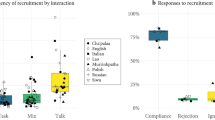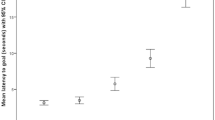Abstract
Captive animals trained to cooperate with routine medical procedures, such as injections, may experience less aggression and anxiety than those forced to comply through the use of restraints. The authors used positive reinforcement training to teach captive chimpanzees to present a body part for anesthetic injection and determined the time investment necessary for initial training and duration of maintenance of the behavior after completion of the training.
This is a preview of subscription content, access via your institution
Access options
Subscribe to this journal
We are sorry, but there is no personal subscription option available for your country.
Buy this article
- Purchase on Springer Link
- Instant access to full article PDF
Prices may be subject to local taxes which are calculated during checkout




Similar content being viewed by others
References
Novak, M.A. & Suomi, S.J. Psychological well-being of nonhuman primates in captivity. Am. Psychol. 43(10), 765–773 (1988).
Novak, M.A. & Petto, A.J. Through the Looking Glass: Issues of Psychological Well-Being in Captive Nonhuman Primates (American Psychological Association, Washington, DC, 1991).
Reinhardt, V. Avoiding undue stress: catching individual monkeys in groups of rhesus monkeys. Lab Anim. (NY) 19(6), 52–53 (1990).
Fritz, J. & Howell, S. Enrichment programs for assurance of psychological well-being of captive chimpanzees (Pan troglodytes). Am. J. Primatol. 30(4), 311–312 (1993).
Sheperdson, D., Mellen, J. & Hutchkins, M. Second Nature: Environmental Enrichment for Captive Animals (Smithsonian Institutional Press, Washington, DC, 1997).
Howell, S.M. & Fritz, J. The nuts and bolts of captive chimpanzee diets and food as enrichment: a survey. J. Appl. Anim. Welf. Sci. 2(3), 205–215 (1999).
Reinhardt, V. Working with rather than against macaques during blood collection. J. Appl. Anim. Welf. Sci. 6(3), 189–197 (2003).
Home Office. Animals (Scientific Procedures) Act 1986. Code of Practice for the Housing and Care of Animals Used in Scientific Procedures (Her Majesty's Stationary Office, London, 1989).
Vertein, R. & Reinhardt, V. Training female rhesus monkeys to cooperate during in-homecage venipuncture. Lab. Prim. Newslett. 28(2), 13 (1989).
Reinhardt, V. & Cowley, D. Training stumptailed monkeys (Macaca arctoides) to cooperate during in-homecage treatment. Lab. Prim. Newslett. 29(4), 9–10, 1990.
Reinhardt, V. Training adult male rhesus monkeys to actively cooperate during in-homecage venipuncture. Anim. Technol. 42(1), 11–17 (1991).
Phillippi-Falkenstein, K. & Clarke, M.R. Procedure for training corral-living rhesus monkeys for fecal and blood sample collection. Lab. Anim. Sci. 42(1), 83–85 (1992).
Luttrell, L., Acker, L., Urben, M. & Reinhardt, V. Training a large troop of rhesus macaques to cooperate during catching: Analysis of the time investment. Anim. Welf. 3(2), 135–140 (1994).
Reinhardt, V. Refining the blood collection procedure for macaques. Lab Anim. (NY) 32(1), 32–35 (1996).
Schapiro, S.J., Perlman, J.E. & Boudreau, B.A. Manipulating the affiliative interactions of group-housed rhesus macaques using positive reinforcement training techniques. Am. J. Primatol. 55(3), 137–149 (2001).
Anzenberger, G. & Gossweiler, H. How to obtain individual urine samples from undisturbed marmoset families. Am. J. Primatol. 31(1), 223–230 (1993).
Turkkan, J.S. New methodology for measuring blood pressure in awake baboons with use of behavioral training techniques. J. Med. Primatol. 19(5), 455–466 (1990).
Priest, G.M. Training a diabetic drill (Mandrillus leucophaeus) to accept insulin injections and venipuncture. Lab. Prim. Newslett. 30(1), 1–4 (1991).
Priest, G.M. The use of operant conditioning in training husbandry behaviors with captive exotic animals. Proceedings of the 16th National Conference of the American Association of Zoo Keepers 94–108 (1990).
Byrd, L.D. in Progress in Ape Research (ed. Bourne, G.H.) 161–165 (Academic Press, New York, NY, 1977).
McGinnis, P.R. & Kraemer, H.C. in Comfortable Quarters for Laboratory Animals 20–27 (Animal Welfare Institute, Washington, DC, 1979).
Bloomsmith, M.A., Stone, A.M. & Laule, G.E. Positive reinforcement training to enhance the voluntary movement of group-housed chimpanzees within their enclosures. Zoo Biol. 17(4), 333–341 (1998).
Bloomsmith, M.A., Laule, G.E., Alford, L. & Thurston, R.H. Using training to moderate chimpanzee aggression during feeding. Zoo Biol. 13(6), 557–566 (1994).
Stone, A.M., Bloomsmith, M.A., Laule, G.E. & Alford, P.L. Documenting positive reinforcement training for chimpanzee urine collection. Am. J. Primatol. 33(3), 242 (1994).
Laule, G.E., Thurston, R.H., Alford, P.L. & Bloomsmith, M.A. Training to reliably obtain blood and urine samples from a diabetic chimpanzee (Pan troglodytes). Zoo Biol. 15(6), 587–591 (1996).
Lambeth, S.P., Perlman, J.E. & Schapiro, S.J. Positive reinforcement training paired with videotape exposure decreases training time investment for a complicated task in female chimpanzees. Am. J. Primatol. 51(S1), 79–80 (2000).
Hassimoto, M., Harada, T. & Harada, T. Changes in hematology, biochemical values and restraint ECG of rhesus monkeys (Macaca mulatta) following 6-month laboratory acclimation. J. Med. Primatol. 33(4), 175–186 (2004).
Reinhardt, V., Liss, C. & Stevens, C. Restraint methods of laboratory nonhuman primates: a critical review. Anim. Welf. 4(3), 221–238 (1995).
Lambeth, S.P. et al. Positive reinforcement training affects hematologic and serum chemistry values in captive chimpanzees (Pan troglodytes). Am. J. Primatol. 62(S1), 37–38 (2004).
Perlman, J.E., Thiele, E., Whittaker, M.A., Lambeth, S.P. & Schapiro, S.J. Training chimpanzees to accept subcutaneous injections using positive reinforcement training techniques. Am. J. Primatol. 62(S1), 96 (2004).
Laule, G. & Whittaker, M. in The Care and Management of Captive Chimpanzees (ed. Brent, L.) 243–265 (American Society of Primatologists, San Antonio, TX, 2001).
Pryor, K. Don't Shoot the Dog! The New Art of Teaching and Training (Bantam Books, New York, NY, 1984).
Acknowledgements
Thank you to all PFA care and research staff and volunteers, especially Kelly Carbone and Kristi Lewton. Partial support for this study came from the University of Texas, M.D. Anderson Cancer Research Center, subcontract U42 RR 15090-02, within the National Institutes of Health Biomedical Research Program.
Author information
Authors and Affiliations
Corresponding author
Ethics declarations
Competing interests
The authors declare no competing financial interests.
Rights and permissions
About this article
Cite this article
Videan, E., Fritz, J., Murphy, J. et al. Training captive chimpanzees to cooperate for an anesthetic injection. Lab Anim 34, 43–48 (2005). https://doi.org/10.1038/laban0505-43
Received:
Accepted:
Issue Date:
DOI: https://doi.org/10.1038/laban0505-43
This article is cited by
-
Opportunities and Challenges in Applying the 3Rs to Zoos and Aquariums
Journal of Agricultural and Environmental Ethics (2022)



